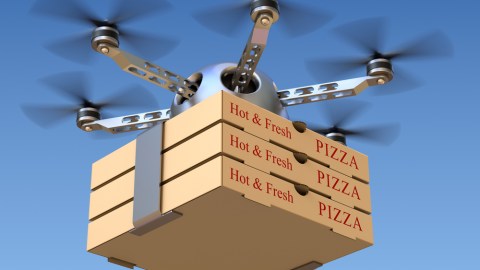From Meals-on-Wheels to Dinner-by-Drone

Drones are all the buzz today. They make the news regularly appearing everywhere and often where they don’t belong — baseball stadiums, concert stages and even the White House lawn. Is it time for firms that are the silent partners of family caregivers supporting older adults and aging services providers to jump on the drone bandwagon?
Drones are portrayed as providing new ways to conduct surveillance, deliver “stuff,” or just to have fun. Amazon certainly captured the imagination with its “octocopter” research project where drones might deliver goods to your doorstep 30 minutes from the time of the order. Nearly all of the emerging drone applications are creative, but sometimes they are creepy. For example, a Maine farmer uses a drone to herd his sheep. Cool. While in Vancouver, a “peeping drone” was reported by residents of an apartment building. Creepy.
It is time for the public sector, volunteer organizations, and many companies that are the “go to” solution for families (e.g., pharmacy chains, grocery stores) to explore how these robotic technologies or autonomous systems could bring greater efficiency and service to caring for an aging society. According to Gallup, family caregivers spend nearly 13 days per month on tasks and errands such as grocery shopping, doing laundry, and running errands. It is unclear how much of that time is spent on shopping and delivery — what is clear is that a caregiver’s most valuable asset is their time.
Let’s dream a bit. Point-to-point, near-immediate service delivery offers a new, and perhaps more efficient, more environmentally friendly home-logistics system for the elderly and their caregivers.
Home delivery of goods today is thought of as a convenient and traffic-congestion-beating personal logistics strategy. With a rapidly aging population, however, convenience may soon become a secondary value compared to the desire for 24/7 reliable support of the homebound and of the families who help them.
In the near future, can we imagine groceries being drone-dropped not just to the time-crunched dual-income couple with children, but also to the doorstep of an older adult who is no longer comfortable or capable of driving to the local market. Will national pharmacy chains offer branded drone delivery of both OTC and prescription medications?
Human services might also consider the future of autonomous systems. Meals on Wheels is perhaps one of the most successful public programs supporting older homebound Americans. Born out of the Older Americans Act, the program uses volunteers to deliver a warm meal and a warm smile to nearly one-third of Americans over 60 years old. Despite the national need and the program’s success, funding from the federal government and other sources is at risk. Moreover, demand may be outstripping the number volunteers available. Countless communities across the nation are reporting “critical volunteer” shortages. In Dubuque, Iowa, they are reinstituting a gas stipend to incentivize volunteers to join. In Syracuse, New York, they are holding open houses hoping to recruit needed volunteers. In one northern California community, Meals on Wheels is described as “struggling to stay afloat” in the face of volunteer shortages. There are certainly many technical, social, and local challenges to make dinner-by-drone possible. However, where volunteers and funding are in short supply, it may be time to think of drones as more than a force multiplier for just the country’s military, but a powerful force multiplier for the nation’s care force as well.
Drones, or any autonomous system, will not, and should not, replace high-touch. Social connection and family support are as important to overall well-being as ensuring that food is in the fridge and medications are in the cabinet. For example, organizations such as Store to Door, which provides volunteer grocery shopping and delivery for older people, includes in its tagline that that it delivers far “more than groceries.” Human contact matters. However, drone delivery may offer a new way of managing the time, financial, and even congestion costs of selected caregiver tasks — e.g., grocery shopping, delivery of home medical supplies, meals, etc. Drones may even be an important strategy for public programs managing tight budgets and too few volunteers. The benefits could be more than cold economic savings, but the capacity to smartly allocate time once spent in traffic, to face-to-face, hand-in-hand time — sharing a meal, enjoying a chat, or going out to visit a friend. Imagine the irony, an autonomous system that enables quality human-to-human contact.
Image by Shutterstock




